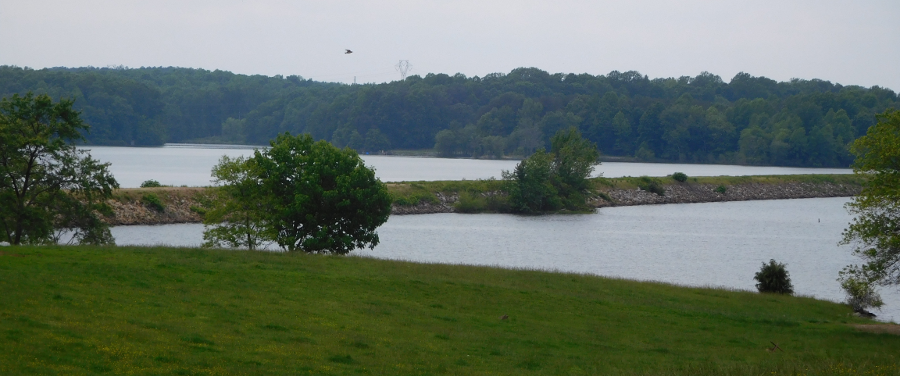
the two reactors at the North Anna Nuclear Power Station are cooled by water from Lake Anna, and that heated water is discharged into a separate portion of the lake isolated by three dikes so it can discharge the excess heat to the atmosphere

the two reactors at the North Anna Nuclear Power Station are cooled by water from Lake Anna, and that heated water is discharged into a separate portion of the lake isolated by three dikes so it can discharge the excess heat to the atmosphere
Virginia has four commercial nuclear reactors generating low-cost electricity, using the Westinghouse, three-loop, pressurized water design. Two reactors were built at the Surry Nuclear Power Plant, and the other two reactors are located at the North Anna Power Station in Louisa County. North Anna 1 started in 1978, and North Anna 2 in 1980. They are capable of generating a total of 1,863 megawatts.
Dominion Power, a private investor-owned utility, built and operates the reactors. Rural Louisa County benefits from the high property taxes paid on the high-value facilities. The lake built to cool the reactors also attracted high-end residential development. Locals refer to the southern edge of the lake, where cooling water is released, as the "hot side."1
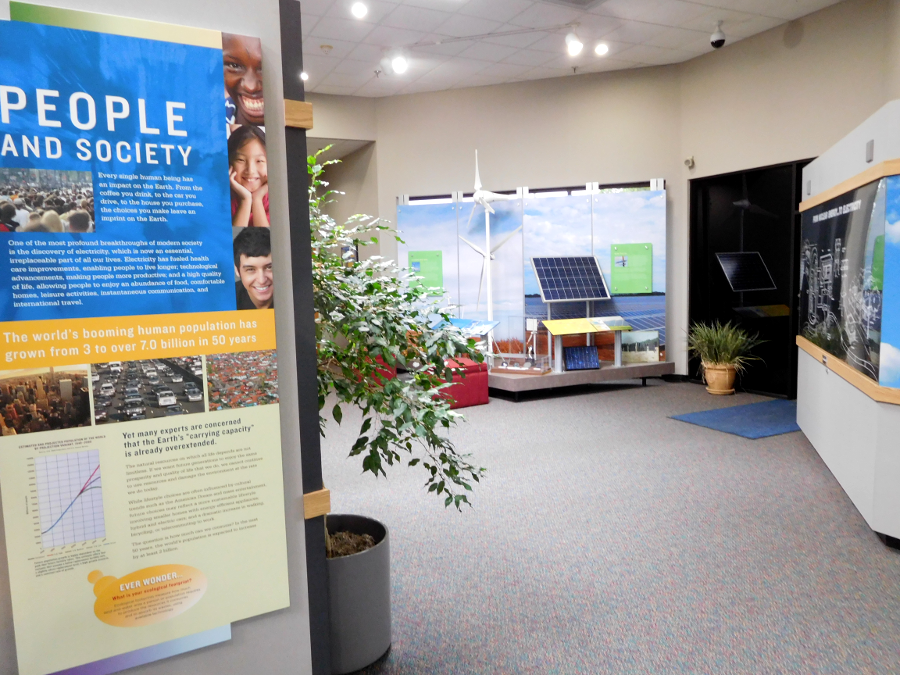
exhibits in North Anna Power Station visitor center (Louisa County)
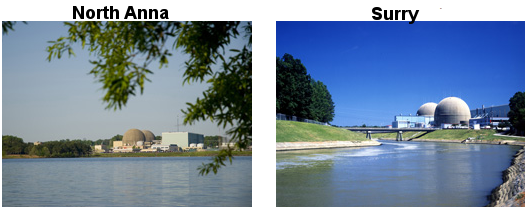
nuclear power plants were built at locations with adequate cooling water
Source: Nuclear Regulatory Commission, North Anna and Surry, Power Stations - License Renewal Application
Nuclear reactors at commercial power plants are most efficient when running at a steady rate, so the North Anna Power Station is used for baseload rather than peaking power. Baseload plants run 24 hours per day and supply the electricity needed even when demand is at its lowest level. In contrast, peaking plants are turned on and off during the day, and supply extra energy needed in the morning (when people wake up, get ready for work/school, and turn on lights/hairdryers etc.) or in the evening (when people come home and cook dinner, do laundry, etc.).
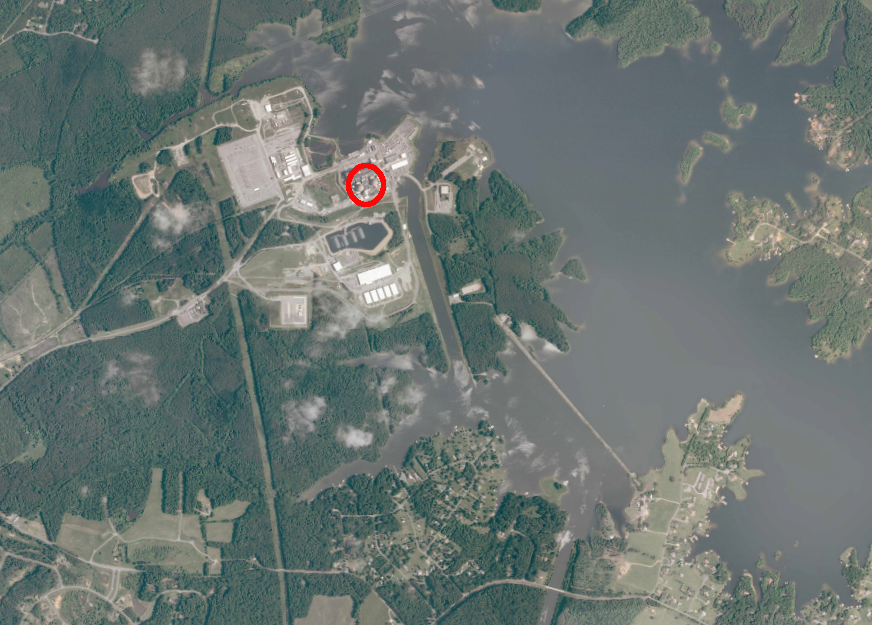
Lake Anna was built in 1971 to provide cooling water for nuclear reactors - note channel next to (circled) reactors
Source: U.S. Geological Survey (USGS), Lake Anna West 7.5x7.5 topographic quadrangle (2010)
Dominion Energy has invested in planning to add a new 1,470 megawatts reactor at the North Anna site. The utility submitted an Early Site Permit (ESP) proposal to the Nuclear Regulatory Commission based on a larger, 1,700 megawatt reactor based on a different design (the Advanced Pressurized Water Reactor developed by Mitsubishi Heavy Industries), but then proposed to use the Hitachi Economic Simplified Boiling-Water design. The new design would allow for a more cost-effective reactor than the Westinghouse, three-loop, pressurized water design used for Units 1 and 2.
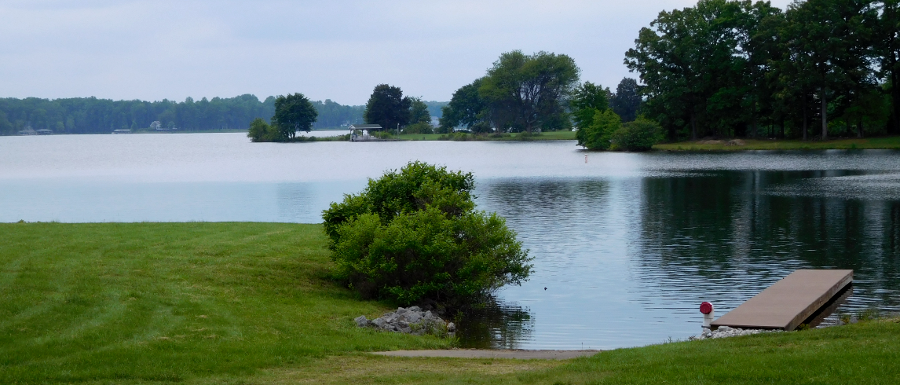
Lake Anna was built to cool water from a nuclear power plant, but waterfront lots have become high-value properties
In addition to financial inducements to shift back to the Hitachi design, Dominion reconsidered safety issues after the nuclear meltdowns at Fukushima and the 5.8 magnitude earthquake with an epicenter very near the Louisa location. The Hitachi Economic Simplified Boiling-Water model has passive gravity-based safety features, including cooling water stored above the reactor, that can keep the core cool for up to seven days even if electrical power to the site was disrupted by an earthquake or other event.2
The third reactor, if built, would be expected to operate for 60 years before being decommissioned. North Anna was chosen for the project, rather than Surry, because there was more space available there and it was located at a preferred location in the high-voltage transmission network.
The utility submitted a Combined Operating License (COL) application to the Nuclear Regulatory Commission in 2007, after receiving an Early Site Permit (ESP) acknowledging the site was suitable for another reactor. It acknowledged that temperatures on the "hot side" of the lake could rise to as 113 degrees in the summer. The license was granted in 2017.
However, the State Corporation Commission made clear that it questioned the cost-effectiveness of spending $19 billion on the third reactor. The only nuclear plants under construction, in South Carolina and Georgia, were far more expensive than initially planned. After spending $600 million on planning the third reactor and getting the Federal license, Dominion suspended its efforts to build the new reactor in late 2017.3
Adding a third reactor increased safety risks, but local residents understood the relative significance of expanding the facility. One resident near the North Anna Power Station commented in 2008:4
Dominion Resources obviously recognizes that the risks of using nuclear fuel differ from other sources of power; spent nuclear fuel assemblies are stored differently from fly/bottom ash residue at coal-fired power plants. After the August, 2011 earthquake (5.8 magnitude, with the epicenter in Louisa County), the North Anna reactors automatically tripped offline. Metal casks storing spent fuel assemblies slid up to 4.5 inches on their concrete pad, and 12 casks ended up closer than the minimum 16-foot separation. The reactors were not restarted for almost three months.5
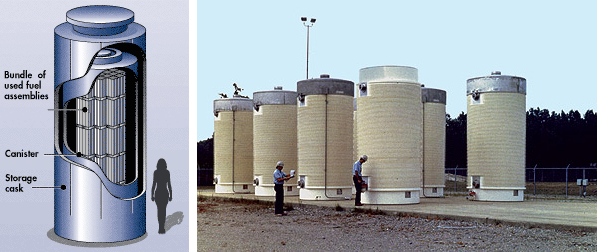
vertical (and horizontal) dry casks are used to store spent fuel assemblies "temporarily" at Lake Anna, since no permanent repository for permanent storage has been built
Source: Nuclear Regulatory Commission, Backgrounder on Dry Cask Storage of Spent Nuclear Fuel and Typical Dry Cask Storage System
The economics of the private company are affected by the costs to manage those risks, including the day in the future when the nuclear power plants must be closed permanently (decommissioned). In its 2004 Annual Report, the utility said that it had set aside $2.6 billion to satisfy the Nuclear Regulatory Commission's minimum financial assurance amounts for the future decommissioning of its nuclear facilities:6
In 2017, the company announced plans to extend the life of the Louisa reactors by another 20 years, and to invest $4 billion on upgrades in order to meet current Federal requirements. The Nuclear Regulatory Commission had licensed the two reactors initially for 40 years, then extended that approval for another 20 years in 2003. A second extension would allow operations to continue until 2058 and 2060.
In September 2020, Dominion Power officially applied for a second renewal to continue operating the North Anna reactors. The Surry approval came first, in May 2021, with approval to operate to 2053. In 2024 the U.S. Nuclear Regulatory Commission authorized North Anna 1 to operate until 2058 and North Anna 2 to operate until 2060.
Nuclear power was key to the utility's plans to meet the Virginia Clean Economy Act requirements for zero-carbon electricity by 2045, after the state legislature defined nuclear-generated electricity as a "clean energy source."7
The alternative to relicensing would be decommissioning the reactors. Dominion calculated in 2010:8
Dominion Energy has purchased liability insurance in case of an accident at North Anna. The maximum coverage offered by private insurance companies is not sufficient to cover potential costs, however. In addition to the $375 million in coverage for each site that Dominion has bought from private commercial insurance pools, the utility also relies upon a $12 billion pool of insurance funded by every utility using nuclear power. The Federal government created the insurance safety net when the Price-Anderson Act was first passed in 1957, to spur commercial use of atomic energy.
Still, fear of nuclear power after the Three Mile Island incident in 1979 limited the development of additional nuclear power plants in Virginia as a source for electricity. The Energy Policy Act of 2005 included new subsidies for nuclear power, and popular support for more commercial nuclear power plants appeared to be growing until the meltdowns at Fukushima, Japan in 2011 after a tsunami.
Nuclear power plants generate no greenhouse gases, but the facilities do generate fear of a disaster. To present the case that nuclear power is safe, Dominion has visitor centers at both the Louisa and Surry plants and even an online tour of a nuclear power plant.9
Disaster plans have been developed for the reactors at Lake Anna, plus the Calvert Cliffs plant 22 miles away in Maryland.
The plans document how people within 10 miles of the reactors would be evacuated from the Plume Exposure Pathway (or Ten-Mile Emergency Planning Zone), based on the assumption that "For the worst core melt sequences, immediate life-threatening doses would generally not occur outside of the zone."
The Ingestion Exposure Pathway (or 50-Mile Emergency Planning Zone) was defined based on the assumption that "Much of any particulate material in a radioactive plume would have been deposited on the ground within 50 miles of the facility."
Sirens were installed to alert people within the Plume Exposure Pathway if an incident justified a special announcement on local TV or radio stations. The sirens were tested four times each year, but by 2021 a survey showed that only 25% of local residents knew to listen to local TV/radio for instructions if the sirens announced a real emergency. The Virginia Department of Emergency Management authorized decommissioning the sirens in 2022, replacing them with a wireless alert system that would trigger messages on smartphones comparable to severe weather alerts.10
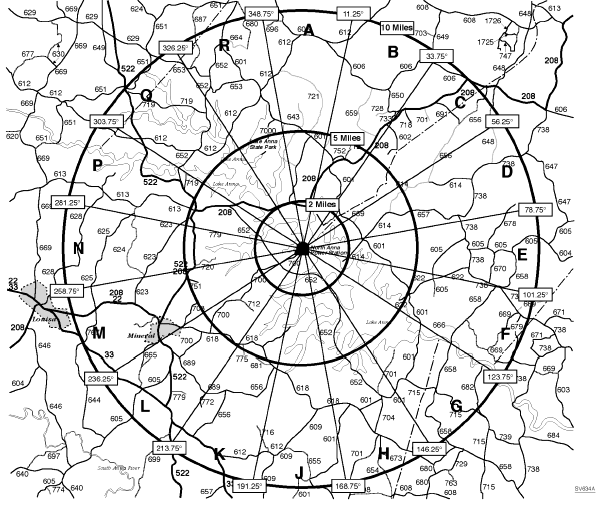
10-Mile Plume Exposure Pathway Emergency Planning Zone and state road map, at North Anna Power station in Louisa County
Source: Dominion Energy North Anna 3 Combined License Application, Part 5: Emergency Plan
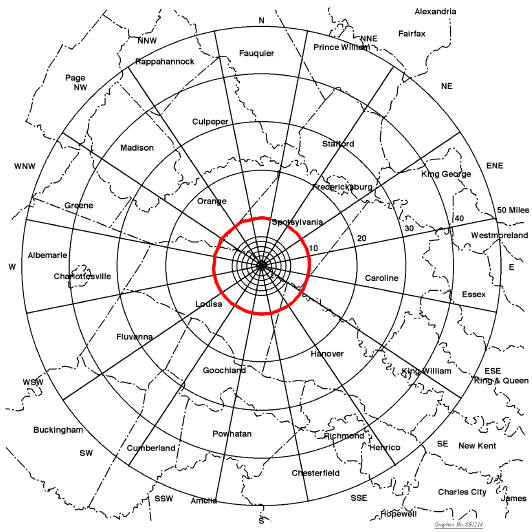
50-Mile Site Ingestion Exposure Pathway Emergency Planning Zone (10-mile zone marked in red)
Source: Dominion Energy North Anna 3 Combined License Application, Part 5: Emergency Plan
The Virginia Department of Emergency Services also risk management plans in case of an accidental release of radiation from nuclear-powered ships in Hampton Roads at the Naval Station Norfolk, the Norfolk Naval Shipyard in Portsmouth, and the Newport News Shipyard. In case of an incident, an Area of Planning Attention extending 0.5-mile from the ship will be declared instead of the 10-mile and 50-mile zones, because the amount of radioactive material on the ships and consequences of an accident is lower.11
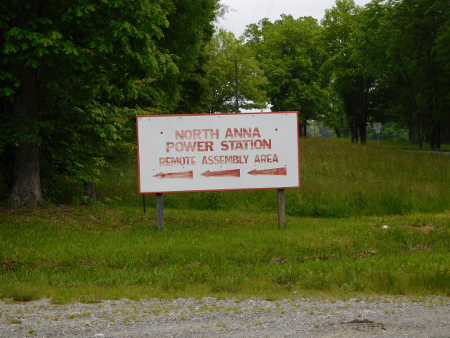
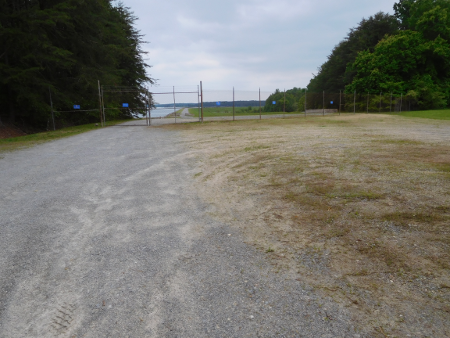
if there is an emergency at North Anna requiring evacuation, the secondary assembly point is at the dam
By comparison, a 12-mile zone was evacuated around the Fukushima plant in 2011, but some locations further away are "hot spots" with excessive radiation levels. After the meltdowns at Fukushima, the US Nuclear Regulatory Commission recommended that all Americans evacuate from a zone within 50 miles of the crippled plants. Later, health inspectors discovered that food from areas far outside the evacuation zone (including ocean-caught fish) were contaminated with radioactive isotopes of cesium.12